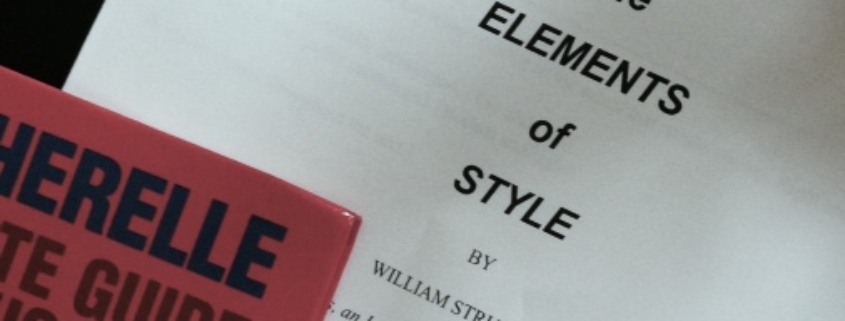One Night, Strunk and White
When my fifth-grader returned home Saturday after a week at Outdoor Science School, she brought a twine necklace strung with acorns and colorful beads, an endless stream of facts about the natural world on the mountain, and several riddles she learned from her counselors. Her week at OSS was the first time she’d been away from home, and so when she ran into the house she was overflowing with excitement about her first trip. The cabins (top bunk!); her meals (dessert every day!); the animals (baby frogs and a corn snake!); the owl pellet she dissected (a mouse skull and a shrew bone!). All day, until she was tucked into her bed and finally lulled to sleep by the tap-tap-tap of raindrops against the window pane, the house was filled with her lispy, delighted, never-ending anecdotes.
I try to be an involved parent. I try to ask the kids engaging questions, encourage them to dig deeper into the events of their day, reflect back to them what they say so they can hear it for themselves, and then allow them to enhance or revise or elaborate. But on Saturday, juggling good parent practices with my overwhelming stack of spring semester work? Let’s just say that while she happily shared her OSS adventures, I alternated between listening and musing on the phrase “what you resist persists.” Open on the table in front of me lay Strunk and White’s The Elements of Style. I had resisted it since high school.
That I have not ever read this slim volume is a bit hard to justify. It takes a day to read, and afterwards not much space on the bookshelf. It’s available for free online in pdf format. Most importantly, though, for an MFA candidate with an affinity toward writing, teaching, and editing, it’s an essential tool that cannot be ignored. Eliminate three out of those four—MFA candidate, writer, teacher, editor—and it is still necessary. When I recently began serving as Blog Editor here at Lunch Ticket, I realized I cannot continue to ride on my grammar and copyediting intuition. I need the vocabulary to explain my editorial suggestions. I need clear reasoning for my choices. I need cold, hard, plain, simple, black and white—Strunk and White—guidance.
Dry, right? Elements of Style, though, is not as much about boring rules as it is intelligent advice. All writers of any genre need to craft clear, effective, engaging, bold sentences. Whether novelist, memoirist, or blogger, not having a handle on these tips is a liability.
In E.B. White’s introduction, he quotes from Strunk’s principle #17 (omit needless words):
Vigorous writing is concise. A sentence should contain no unnecessary words, a paragraph no unnecessary sentences, for the same reason that a drawing should have no unnecessary lines and a machine no unnecessary parts. This requires not that the writer make all sentences short or avoid all detail and treat subjects only in outline, but that every word tell.
“That every word tell,” I reread several times. It is a compelling statement. With the drawing and machinery comparisons, it hits home. Unnecessary words and unfocused structure are part of the first-draft process, but a discerning reader can tell a first draft from a polished piece. First drafts hem and haw. They clear their throats and hesitate over ideas. They meander. A discerning reader—an editor, say—may wade through, but a non-discerning reader won’t spend the time traversing rough spots to mine the gems. They will simply move on to another story. Strunk and White’s statement is, in four words, an argument for careful revision. The Elements of Style provides the writer a checklist for that process.
The book begins with basic punctuation and grammar rules that any writer should inherently know, followed by a list of composition principles I wish every blogger, essayist, reporter, memoirist, novelist—even Facebook poster, dare I suggest—would consider. Structure of the parts, and of the whole. Clarity of expression. Parallel construction of ideas. Economy of words. Verb tense agreement.
While I scratched notes into the margins, my kid bounced off the couch.
“Do you like riddles?” she asked, stopping her dance mid-twirl, arms spread out wide. At ten, truly, all the world’s a stage.
She is an effervescent joy to our family. She has super powers, has been writing a book since third grade, and has well-timed, absurdist humor. It seems, while she has watched her older sister navigate teenage dramas, she dug her heels into childhood, determined to hang on to simple pleasures until life insists on the inevitable next phase. I can’t say if it’s her jokes or her giggles, but at least once a week we all—even the teenager—end up laughing till we’re in tears.
Here’s one of the riddles she brought home from OSS:
Q: One night, a king and a queen went into a castle. The next day, three people came out. What happened?
A: One knight, a king, and a queen went into a castle. Obviously, the homophone is the key. Night/Knight.
Half-listening to her and half-studying Strunk and White led me to consider this riddle from a craft perspective, and I found two other tricks within it that are meant to confound the listener. Sleight of hand is a puzzler’s prized tool, and a riddle’s only goal is to hide an answer in plain sight. When this teaser is spoken aloud, you can almost hear the lack of comma between “a king and a queen”. A serial comma, as I inserted in the answer above, further helps to reveal the three people who emerged from the castle.
The most cunning tricks, though, are the most subtle. As I turned this teaser over, a topic covered in Part II of The Elements of Style came to mind. This is a principle Strunk and White call “express coordinate ideas in similar form.” They write:
This principle, that of parallel construction, requires that expressions similar in content and function be outwardly similar. The likeness of form enables the reader to recognize more readily the likeness of content and function.
Exactly contrary to Strunk and White, this riddle utilizes non-parallel structure to help mask its solution. One k/night is followed by a king and a queen. This use of non-parallel structure is meant to trick the listener.
Until now I’d never dissected a riddle. I suppose if you are a riddler, you might consider using non-parallel structure as a tool to disguise the solution. For other writers, however, our goal is not to confound the reader, but to write as clearly as possible. We puzzle in our process so there is no confusion in our final manuscript. We should always strive to give a reader the clearest expression of our thoughts. For parallel structure, we would write one knight, one king, and one queen or a knight, a king, and a queen. Parallel structure. Clarity of expression. Concise writing.
As my joyful kid twirled her way through the afternoon, and I made my way through The Elements of Style, I found myself siding with past teachers who once waved their copy of this book to the class. Anne Lamott writes in Bird by Bird, “the only way I can get anything written at all is to write really, really shitty first drafts.” She goes on:
You need to start somewhere. Start by getting something—anything—down on paper… [But] the third draft is the dental draft, where you check every tooth, to see if it’s loose or cramped or decayed, or even, God help us, healthy.
Another joke from OSS:
The present, the past, and the future walk into a bar. It was tense.
With all those mixed tenses hanging out together, I am sure it was. Luckily, this and other things are covered in a beautifully quick read: The Elements of Style.
What, you don’t have a copy? Get a copy here (or wherever you like to get books), or download a pdf version here.








